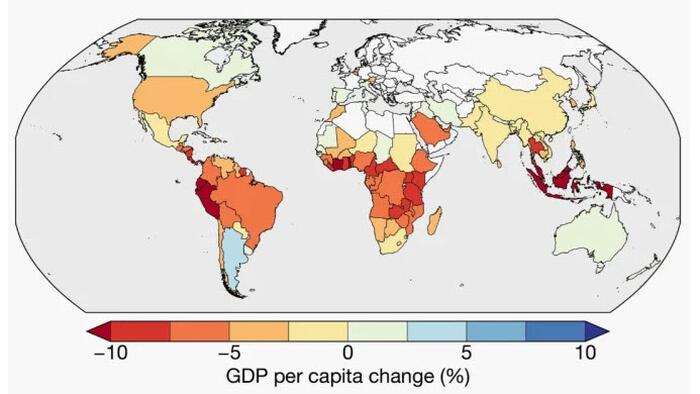Those of us in the dry Southwest desert and Southern California welcome the end of La Niña and the return of badly needed snow and rain. Much of the rest of the world, sees things differently. Mish Talk
From Dartmouth College comes a doomsday prediction from Christopher Callahan, an Earth system scientist. He claims in this report*, that it could be a $3 trillion hemorrhage over the next several years, with low-income tropical countries getting hit especially hard as El Niño waters warm in the Pacific, tropical countries bear the bulk of the knock-on effects.
REMINDER: El Niño is a naturally occurring climate phenomenon that affects the Pacific Ocean and has significant impacts on weather patterns around the world. It is characterized by the warming of sea surface temperatures in the central and eastern tropical Pacific Ocean, which can have widespread effects on global weather systems.
During an El Niño event, the normal patterns of atmospheric and oceanic circulation in the tropical Pacific become disrupted. The trade winds that typically blow from east to west weaken, or even reverse direction, causing warm surface waters to move eastward. This results in an increase in sea surface temperatures in the central and eastern Pacific.
The warmer ocean temperatures associated with El Niño can influence weather patterns globally. For example, it can lead to increased rainfall in parts of the eastern Pacific, including parts of South America, and reduced rainfall in some areas of the western Pacific, such as Australia and Indonesia. El Niño can also affect the intensity and location of tropical cyclones and hurricanes.
The impacts of El Niño can vary from event to event and depend on various factors, such as the strength and duration of the event. Its effects can be felt over several months to a year or more. After an El Niño event, the climate typically returns to its normal state, although the transition period can sometimes lead to another climatic phenomenon called La Niña, which is characterized by cooler-than-normal sea surface temperatures in the eastern Pacific. This is the phase we are leaving now.
El Niño is a natural climate variability pattern that has been occurring for centuries and has its own distinct characteristics and impacts. While scientists continue to study the factors that contribute to El Niño events, including oceanic and atmospheric processes, the focus here is solely on describing the phenomenon itself without any reference to long-term climate trends or influences.
Callahan sees this El Niño as a stress test for a warming planet, as climate change makes heat waves, wildfires, droughts, and rainfall more intense. But it’s also an opportunity for governments to shore up their preparations for extreme weather. “These things like hardening your infrastructure and investing in wildfire management are going to be necessary,” says Callahan. “And so we think there’s really sort of a win-win here.”
Not buying it
Do we really think that the US economy will suffer a loss of 2.5 percent to 5.0 percent of per capita GDP because of wetter weather in California?
In El Niño years, Canada, Australia and especially Argentina allegedly benefit, while faraway Europe is mostly unchanged.
*Abstract
El Niño–Southern Oscillation (ENSO) shapes extreme weather globally, causing myriad socioeconomic impacts, but whether economies recover from ENSO events and how anthropogenic changes to ENSO will affect the global economy are unknown. Here we show that El Niño persistently reduces country-level economic growth, attributing $4.1T and $5.7T in global income losses to the 1982–83 and 1997–98 events, respectively. Increased ENSO amplitude and teleconnections from warming cause $84T in 21st-century economic losses in an emissions scenario consistent with current mitigation pledges, but these effects are shaped by stochastic variation in the sequence of El Niño and La Niña events. Our results highlight the sensitivity of the economy to climate variability independent of warming and the potential for future losses due to anthropogenic intensification of such variability.

